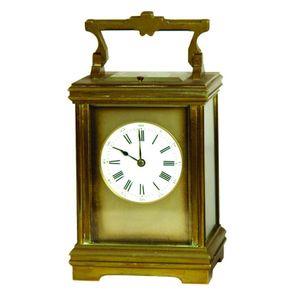19th Century Brass Carriage Clock with Fitted Case
You must be a subscriber, and be logged in to view price and dealer details.
Subscribe Now to view actual auction price for this item
When you subscribe, you have the option of setting the currency in which to display prices to $Au, $US, $NZ or Stg.
- Movement - The technical name for the workings of a clock or watch, and does not include the dial or case.
- Barrel (in a Clock) - In a clock or watch, the barrel is a cylindrical component that stores the energy from the mainspring. As the mainspring is wound, it stores energy in the barrel. As the clock or watch runs, the energy is gradually released from the barrel, turning the clock's gears and keeping the time.
The barrel is typically located near the centre of the movement (the mechanism that powers the clock) and is connected to the center wheel, which drives the rest of the gears. The barrel typically has teeth on its outer surface that mesh with the gears in the movement, allowing it to transmit energy to the rest of the clock. Some barrels are designed to be wound by hand, while others are automatically wound by the motion of the wearer's arm. - Back Plate - On many types of clocks, the movement operates between two plates, usually made of brass, one at the back, and the other at the front, which forms a mount for the dial.
On English bracket, mantle and table clocks the backplate was often visible through a glass door or panel from the late 17th century, and could be profusely engraved with scrolling decorations, flowers, foliage, birds, and figures. The engraving could also include the maker?s name.
The amount of engraving reduced and became simpler as the 18th century progressed, and by 1800, had been reduced to a border, often with the maker's name in the centre. By the early 1800s all decoration had ceased, and only the maker's name was added, and by the Victorian era, most bracket, mantle and table clocks had no engraving.
This item has been included into following indexes:
- clocks, carriage
Visually similar items

A 19th century French gilt brass carriage clock, the four pillars with turned and fluted decoration, the silvered chapter ring with Arabic numerals, Art Nouveau relief floral decorated face, working order.

A 19th century French brass cased repeating carriage clock, the swing handle with decorative chamfered design, bracket base, the working movement striking on a gong, the case measuring 10 x 8.5 x 13.5 cm

A Henry Capt, Geneve gilt brass and enamel striking and repeating carriage clock with alarm, circa 1890. Signed 'Henry Capt, Geneve, Ls Gallopin & Cie Succes', the guilloche and enamel front and side panels depicting orchids in lustre enamels, handle and r

A late 19th century French fancy brass cased carriage clock, the gilt dial with stylised floral pierced grill, enamelled chapter ring with Arabic numerals, with key, not working.
